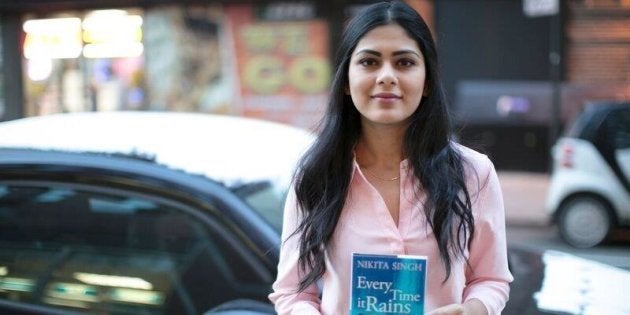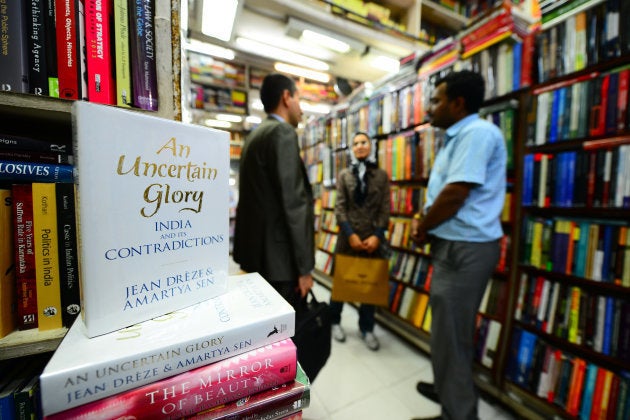
"I was inspired to take up writing after reading a really shitty book," says Nikita Singh, without missing a beat, to a question from a participant at a Bloggers' Brunch, organised by Women's Web in Bengaluru last weekend. "When I was 19, I read this book by this really famous writer, who I won't name, and I thought, seriously, I could do a better job than this!"
The rest, as they say, is history.
At 25, Singh sits holding her tenth novel, Every Time It Rains, before the 15 odd people who have showed up on a Saturday morning for an exclusive tete-a-tete with her. One of them, I'm told by her publicist, is a 'fan' who's been following her since her promotional tour in Kochi, where he was frustrated to discover that no bakeries were willing to deliver her a cake. Finally, he had to turn up with just a piece of a cake. "I had to tell him I'm lactose intolerant but, of course, it's the thought that counts," Singh adds.
At 25, Singh sits holding her tenth novel, Every Time It Rains, before the 15 odd people who have showed up on a Saturday morning for an exclusive tete-a-tete with her.
He did, however, greet Singh with a bouquet of yellow flowers the moment she left the stage after a panel at the Bangalore Literature Festival the day after. When I approached him, the bearded young man was too shy to speak to "the media". So I had to be content with stealing sly glances at his reaction as Singh spoke. I caught him staring at her, face fixed into an adoring grin.
I'm sure many writers would kill to have a fan like him, even though his behaviour does appear to border on stalking.

Small Town, Big Dreams
In the ever-burgeoning segment of romance fiction by Indians writers, Singh is a prominent name. Her books sell 20,000-25,000 copies on an average, though her rise to stardom was not exactly a copybook fairytale. In an interview with Hindustan Times in 2015, Singh said the Harry Potter series was the first books she ever read for pleasure at the age of 17. She wrote her first novel, almost as a dare to her younger sister, a couple of years later and sent it off to as many publishers as she could find online.
The first response hit her inbox in two days. It was a favourable one from a small publisher, Pustak Mahal, who brought out the book in a few weeks. You'd think Singh must have been over the moon. But the reality turned out to be more complicated.
Within days of Singh's first novel, Love@Facebook, being published, Vaishali Mathur, currently Executive Editor at Penguin Random House and publisher of India's most successful commercial imprint Metro Reads, wrote to Singh with an offer for the same book. Eventually, they signed a deal for a different book, though even before Singh had got it going, she was pinged on Facebook by none other than the Durjoy Datta, the dimpled heartthrob of romance readers in India. He wanted her to work with Grapevine, a publishing start-up he was launching with his friend and fellow writer Sachin Garg.
Singh and Datta went on to collaborate on successful books, but it only in her last few solo ventures Singh seemed to have found her voice.
Singh and Datta went on to collaborate on successful books, but it's only in her last few solo ventures Singh seemed to have found her voice. Her plots are not the assembly line Mills and Boons-type romance, where damsels in distress fawn over tall, dark and handsome heroes. Nor are they sticky with sentimental heroes wondering if love can happen twice.
Singh's novels, in spite of their romance packaging, offer a reality check instead, often a brutal one, focusing on the real-life troubles of the generation that dates on Tinder, likes to go clubbing, takes risk in love and makes fatal mistakes. Far from mush, these 20-something urban men and women are pragmatic, career-driven, cynical, full of regrets, though not entirely without hope for a better life. Or love.

Part-Romantic, Part-Realistic
When it comes to breaking out of the mould, Singh has done it multiple times already. Born in Ranchi, raised in Patna, Indore, Ranchi and in a village near Indore, she had a protected upbringing and all the limitations of a small-town girl to deal with.
"I wasn't even allowed to go to the mall on my own," she says, "My brothers would drop me and pick me up." Her parents would call to check on her when she was out. But in the last six years, not only did she move to a big city — to the national capital, no less — but also out of the country, to go to college in the US. The scale of her life, as well as ambitions, had grown manifold.
"My parents were supportive of my writing, but not many girls in Tier 2 or 3 cities in India have such luck," says Singh, when I ask her about the dominance of male writers over the romance genre in India. "Women don't get as many chances as, say, a writer like Ravinder Singh."
"Nikita is perhaps the only female writer in this genre who's able to keep the stories contemporary, build both her male and female characters equally and write books that connect with the youth," adds Mathur, who has worked with her over several books. "The fact that she herself is very young, and therefore knows and connects with her target readers, adds to her profile."
Unlike the scorn commercial fiction writers tend to get in India, the scene abroad is much different. "It's so easy for the 'literary elites' here to dismiss us," says Singh.
But the challenges are there, many of them set up by Singh herself.
It all started with her decision to apply to the New School in New York City. With seven chick-lit titles on her CV and a degree in pharmacy, she was accepted at the age of 22. "In India, all the writers I hung out with were happy with their lives. They were only worried about their ranking in the AC Nielsen list," says Singh. "I didn't want to become complacent. I wanted to become a better writer."
Unlike the scorn commercial fiction writers tend to get in India, the scene abroad is much different. "It's so easy for the 'literary elites' here to dismiss us," says Singh. "Your own confidence as a writer, especially as a woman, goes down in this country." In New York, though, the impressive number of her published titles and her popular success were "appreciated".
The snobbery with which a certain class of English fiction readers approach commercial writing in India is undeniable. Anyone is within their right to detest a Chetan Bhagat novel, rip it apart in as many Facebook posts as they like, but to disregard the taste of a vast section of readers, some of whom may be only just starting to read in English, is to cocoon oneself into an intellectual echo chamber.
"I've become scarce on Facebook because I get a lot of hate there, which is difficult to filter sometimes," says Singh. "I mean how do you pick up a book like Every Time It Rains and not know from the packaging what it's going to be like? Just pick up another book, dude, if you don't like romance!"
Readers of Singh's novels have encountered unusual themes in her books already. Right Here, Right Now is about a woman losing her memory, while After All This Time deals with a character who is HIV positive.
In spite of its obviously romantic cover, with coffee and cupcakes and the works, the story it tells goes far beyond your boy-meets-girl romance. There is that, of course, but also domestic violence and marital rape, to give you a sense of what else to expect.
Readers of Singh's novels have encountered unusual themes in her books already. Right Here, Right Now is about a woman losing her memory, while After All This Time deals with a character who is HIV positive. In the landscape of commercial fiction in India, Singh is an anomaly, a writer whose evolution could not have been harder to predict from her first few books.
"Publishers don't take kindly to such shifts," says Singh, when I ask her about the challenges of writing outside the box of formulaic fiction. "They all want bite-sized fix of urban culture and happy endings."
She has refused to cater to both these plot devices in the last couple of her books, none of which can be said to have the straightforward happy resolution of romances. It was this difference in perspective from the demands of the industry that led her to defect from the country's top publisher to HarperCollins India, Singh says. "Penguin wanted me to write like all its successful romance writers. They wanted to make a superstar out of me," says Singh. "But I wanted to be an actual writer, a good one."
In the last couple of years, Singh's life has changed in more ways than a shift in her writing style. For the first time in her life, she's living away from India and her family, entirely on her own, reading a lot of books she would not (she mentions Jhumpa Lahiri to be her favourite writer and confesses a fondness for Aravind Adiga's The White Tiger), working as a fashion stylist and an editorial consultant for a magazine, apart from writing her thesis on the difference between the books written by Indian writers for "Indian readers" and by those whose target audience is global.
Although she's on a book tour, the next novel is never far from her thoughts. "I allow the ideas grow in my head for about 8 or 9 months, then I write up the first draft in two weeks," Singh says. For now, there are more fans to meet, many more cities to travel to.
Also on HuffPost
